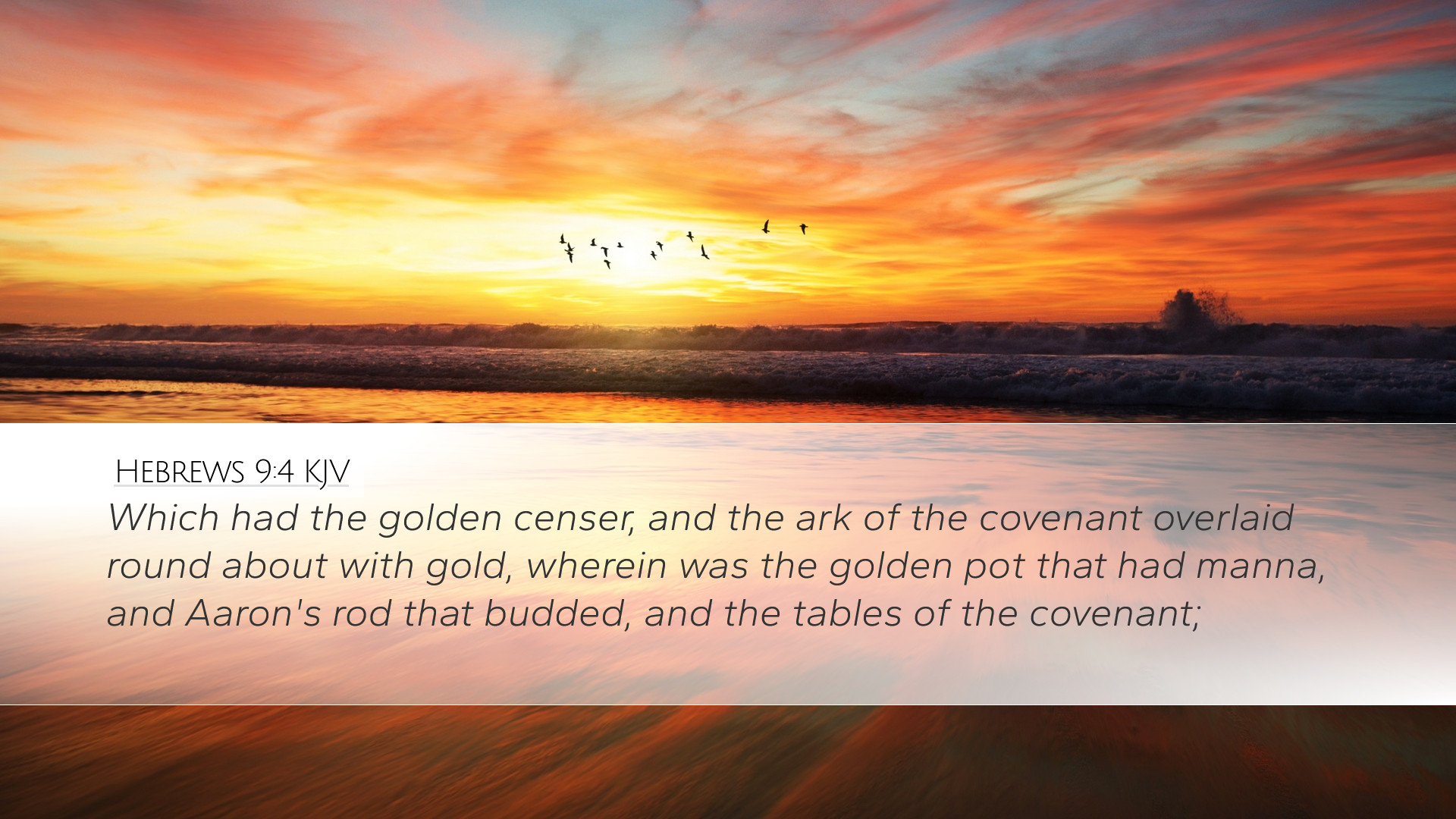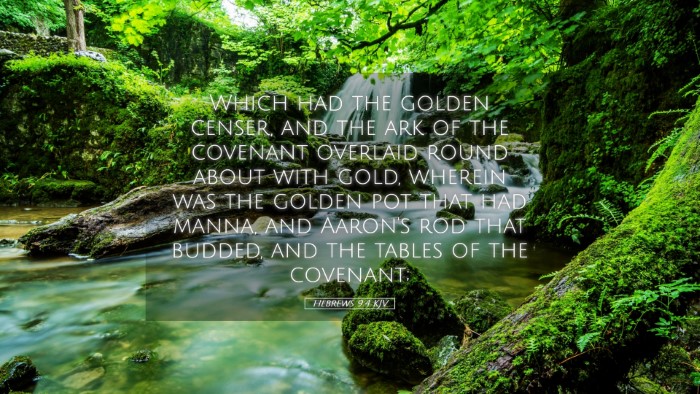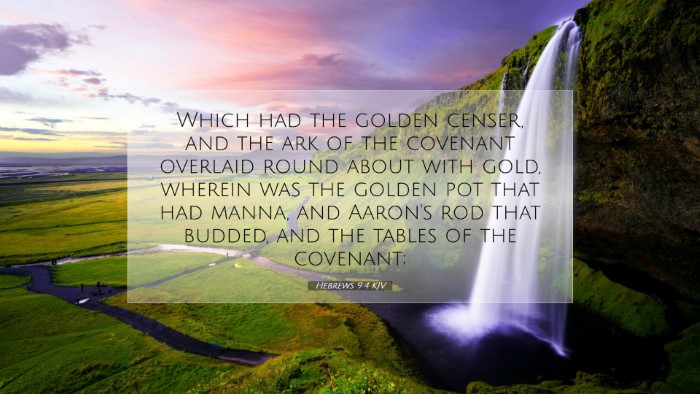Commentary on Hebrews 9:4
Introduction
Hebrews 9:4 presents a crucial insight into the nature and significance of the Old Covenant, particularly the elements associated with the Tabernacle and worship of God. This verse, while seemingly straightforward, encapsulates theological depth and historical significance that can enrich the understanding of pastors, students, and scholars alike.
Text of Hebrews 9:4
“Which had the golden censer, and the ark of the covenant overlaid round about with gold, wherein was the golden pot that had manna, and Aaron's rod that budded, and the tables of the covenant.”
Context and Structure
This verse falls within the broader discussion of the superiority of Christ's priesthood and sacrifice compared to the Levitical priesthood. The author of Hebrews meticulously outlines the components of the Old Covenant system, emphasizing their types and shadows which ultimately point to the greater reality found in Christ.
Historical Background
The tabernacle, as described in the Old Testament, served as the central place of worship for the Israelites during their wilderness wanderings and beyond. The items mentioned in Hebrews 9:4 had profound theological implications and were integral to the worship practices ordained by God.
Analysis of Key Elements
- The Golden Censer: This was an instrument used by the high priest to burn incense before the Lord. The significance of the censer lies in its representation of the prayers of the saints being offered to God (Revelation 5:8). The use of gold indicates the purity and holiness required in approaching the divine.
- The Ark of the Covenant: Often referred to as the most sacred object in Israel's worship, the Ark symbolizes God's presence among His people. It housed the tablets of the Law, underscoring the relationship between God’s covenant and His holiness.
- The Golden Pot of Manna: This item served as a reminder of God's miraculous provision during the Israelites' journey. It demonstrates God's faithfulness and the sustained reliance on His grace for sustenance.
- Aaron’s Rod That Budded: This rod confirmed the divinely ordained leadership of Aaron among the Israelites. It speaks of God's authority and the affirmation of His chosen servant, foreshadowing the greater priesthood of Christ.
- The Tables of the Covenant: These engraved stones represented God’s Law, the moral framework for His people. Their presence in the Ark highlights the centrality of the Law in understanding God’s will and character.
Theological Implications
Each of these elements not only had historical significance but also points to deeper theological truths concerning the nature of covenant relationship between God and humanity.
Types and Shadows
Matthew Henry notes that these objects are types and shadows of more significant realities found in Christ. The efficacy of these Old Covenant artifacts was solely dependent on their reflection of the ultimate High Priest, who is Jesus. The author of Hebrews argues that the physical representations of God's grace in the Old Covenant manifest their ultimate fulfillment in the Christ event.
Role of the High Priest
Albert Barnes emphasizes the role of the high priest in the Old Covenant service, which involved mediating between God and the people. Christ, as the Great High Priest, supersedes this role, offering Himself as the final sacrifice for sin, thus establishing a new and better covenant (Hebrews 8:6).
Christ as Fulfillment
The Apostle Paul, in various epistles, underscores that these objects are surpassed by the reality of Christ's atoning work and His priesthood, which is according to the order of Melchizedek (Hebrews 7:14-17). Adam Clarke emphasizes that they point to the spiritual sustenance found in Christ's body and blood, rather than the physical provisions of the Old Covenant.
Application and Reflection
For contemporary readers, this passage calls for deep reflection on the nature of worship and our relationship with God through Christ.
Understanding Worship
Worship is not confined to ritualistic practices but is a living relationship characterized by faith in the ultimate fulfillment of God's promises through Jesus Christ. The mentioned elements encourage believers to see beyond the physical to the spiritual realities they signify.
Security in Covenant
Just as the Israelites found assurance in the Ark and its contents, believers today find security in the new covenant established through Christ's blood (Luke 22:20). This assurance frees believers from the burden of the law, as they are invited to rest in the completed work of Christ.
Call to Share the Gospel
Understanding these elements invites a fresh zeal to share the Gospel, articulating how the Old Covenant foreshadows an incredible new reality in Christ. Pastors and teachers are encouraged to elucidate these connections, helping congregations appreciate the entirety of God's redemptive plan.
Conclusion
Hebrews 9:4 serves as a reminder of the richness of God’s covenant relationship with His people. As Christians meditate upon its insights, may they recognize the continuity of Scripture and the fulfillment found in Jesus Christ, which ultimately encourages a more profound worship experience and a deeper theological understanding.


